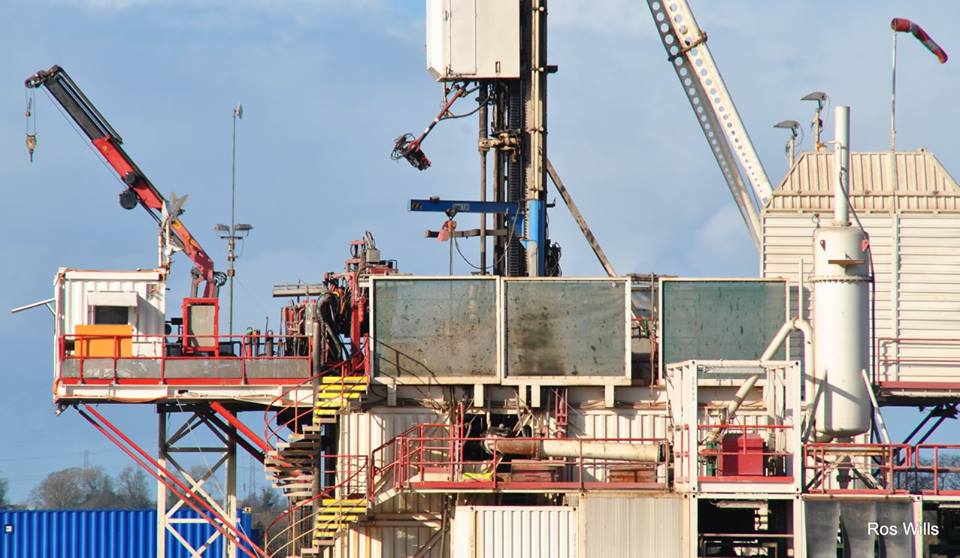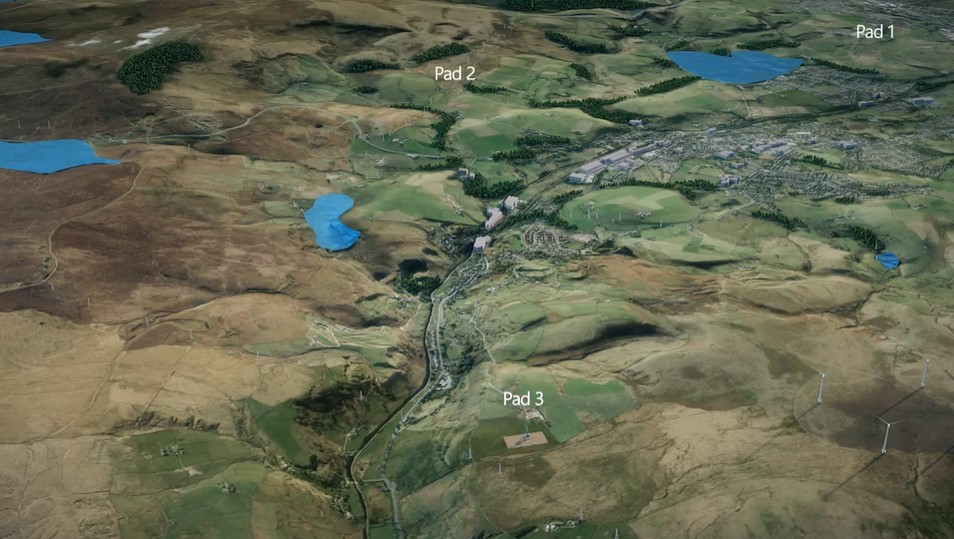
Cuadrilla’s Preston New Road site, 4 February 2018. Photo: Frack Free Creatives Knitting Nanas of Lancashire
One well would have to be drilled and fracked every day for 15 years to produce enough gas to replace half future UK gas imports, according to new study for Friends of the Earth.
The organisation says analysis by Cardiff Business School concluded that about 6,100 medium productivity wells would be needed to cut gas imports by 50% from 2021-2035.
This figure is significantly higher than that predicted a year ago in a study commissioned by the onshore industry.
Friends of the Earth campaigner, Rose Dickinson, said:
“This would mean an industrialisation of our countryside at a rate that nobody has yet fully appreciated and would put many more communities in the firing line of this dirty and unwanted industry.”
Cuadrilla has said it expects to frack two horizontal wells at its site at Preston New Lancashire in the second half of the year. Third Energy is still waiting for approval to frack at Kirby Misperton and doesn’t expect the process to begin before the autumn. Both sites have prompted protests by opponents of fracking. There has also been opposition to plans for new shale gas sites in Nottinghamshire, Derbyshire and south Yorkshire.
Last week, ministers repeated their view that shale gas would contribute to UK energy security and reduce dependence on imports (DrillOrDrop report).
But Friends of the Earth said today that fracking could significantly reduce imports only if “England’s countryside was littered with fracking wells”. The organisation said:
“We need to know what the scale actually looks like, and it’s not looking good for our countryside.”

Cuadrilla’s shale gas site at Preston New Road, 21 March 2018. Photo: Ros Wills
The Cardiff figures
The report’s author, Professor Calvin Jones, used data from the National Grid, which predicted that gas imports would total 695 billion cubic meters for 2021-2035.
To calculate the land needed to replace half the imports, he assumed six wells per pad and a pad size of 3.5ha.
In the central scenario with mid-point well productivity he assumed an estimated ultimate recovery, the amount of potentially recoverable gas from a well, of 0.057 billion cubic metre.
To produce the volume of half the predicted imports, he concluded this would need 6,100 wells across 1,000 pads, covering more than 3,500 hectares. This implies the construction of one shale gas pad roughly every five days over 15 years and one well drilled a day, he said.
The most optimistic well productivity, of 0.085 billion cubic metre, would require 4,090 wells and 680 pads, covering 2,380 ha, the study concluded.
But if the gas produced per well was at the lower end of the range of possibilities, at 0.021 billion cubic metre, the number of wells needed would rise to 16,500. Professor Jones said.
“This equates to drilling and fracking three new wells every day”.
The number of pads needed would rise to more than 2,700, covering an area of over 9,600 hectares.
Professor Jones said UK gas production was likely to be lower and investment and production costs higher than in the US. This is because the US shale geology is easier to exploit and the US has a mature and mobile shale production industry, he said.
He added:
“On current trends there is no evidence that fracked gas can be brought to market at sufficiently low cost, and sufficiently great volume to make any significant profit, or to make any difference to the UK energy security position.”
“Thousands of wells peppered across the landscape”
Daniel Carey-Dawes, senior infrastructure campaigner at the Campaign to Protect Rural England (CPRE) said:
“The fracking industry has always been clear that fracked gas would replace what’s currently imported, but what wasn’t clear was the scale of land take that would involve. The many thousands of wells that would be needed, peppered across our precious landscapes, would cause harm to the English countryside on an industrial scale.
“With technologies now enabling us to effectively harvest renewable energy sources, this is where our efforts, time and money should be invested. The English countryside we know and love is the breathing space for us all. It must not become an industrial testing ground for a fracking industry that has no environmental, economic or social licence.”
Rose Dickinson, of Friends of the Earth, added:
“England is increasingly isolated in desperately chasing fracking when it has already been stopped in Scotland, Wales and Northern Ireland.
“When somewhere is threatened with fracking, opposition is immediate and sustained. It’s time the government banned it and put efforts behind real solutions to supplying energy because fracking won’t help fix climate change. Fracking is unneeded, unwanted and will industrialise our countryside That’s why so many people have come together to keep fracking at bay over the last 7 years”.
Industry figures

Still from industry animation, January 2017. Source: UK Onshore Oil and Gas
The Cardiff predictions contrast markedly with those in a report published in January last year by the onshore oil and gas industry organisation, UKOOG (DrillOrDrop report).
Its study, Developing Shale Gas and Maintaining the Beauty of the British Countryside, predicted 7-11 pads in a 10km licence, with 10 wells on each pad.
At the time, UKOOG’s chief executive, Ken Cronin, said:
“We estimate that approximately 400 well pads developed across the UK between 2020 and 2035”.
DrillOrDrop has invited UKOOG to comment on today’s study. Mr Cronin said:
“This is a poor quality report, which uses data for well productivity which is years out of date and far lower than the current US average to arrive at artificially high numbers of wells. Average production from each well in the US is now nearly twice the level of even the report’s optimistic scenario. We have publicly set out how 4,000 laterals drilled over the next two decades would reduce the UK’s gas imports by half, and we see no evidence in this report to refute that.”
Updated 25/4/2018 to correct feet to metres in productivity measurements and to the difference between the number of wells predicted by the industry.
Categories: Opposition

Collyer we employ what’s known as the precautionary principle. If there is no data, if establishing data will be likely to involve risk (and social division is a 100% consequence of attempting to frack, as a side-issue), if even exploration has long-term legacy issues, we say don’t do it. Simple enough, I would have thought.
But don’t try to bullshit us. Cuadrilla have repeatedly talked about 80-100 wellpads in just one PEDL. Are you calling them serial liars? We know full well if these levels of pad/well density are not met in the north there is NO future for fracking, whatever the results of exploration. It is an idiot’s game. Cuadrilla’s game. Your game. We will not play that. Once in a while it has to be said – your arguments are pathetic, your position is morally unacceptable, and we will not tolerate bullshit promoting the industrialisation of our countryside.
Toot ill-the precautionary principle is not a principle, it is a cop out that would stop the human race developing. It would have certainly excluded using fire or the wheel.Take it to NASA and see what they say. Stop using a keyboard and social (anti in your case) media based upon a precautionary principle.
Based upon the precautionary principle you really should calm down.
There is NOT 100% social division-two thirds surveyed were not divided against fracking, so try not to use the precautionary principle of distorting facts amongst your statements. And those two thirds will enjoy being referred to in your terms, certainly will not be bullied by a minority viewpoint, with the “we” only represented within a proportion of that minority.
Talking about NASA
A NAIL IN THE COFFIN FOR FRACKING
NASA just made a stunning discovery about how fracking fuels global warming
https://thinkprogress.org/nasa-study-fracking-global-warming-0fa0c5b5f5c7/
Excellent post Jackthelad.
Any more NASA nails in the fracking coffin and there will be more nails than coffin?
Cremation seems appropriate? But stand well back?
It’s true Jack, and confirms what Dr Ingraffea (and others) had determined in his pioneering work on ‘top down’ studies. Two EU satellites with remote methane sensing will nail this case closed further no doubt.
Ingraffea has been subjected to the same kinds of abuse and attacks on his credibility that you see getting applied by the pro frackers here – to any research, science or public representatives that don’t whistle their tune.
The tide may be about to turn though. A new class of honest lawyer, with social and environmental conscience, and with clout, is emerging in reaction to the Trump era and the shafting of the EPA by the big looting/polluting interests of the GOP party, and Pruitt. Once their tune changes the dangerous and naive cadres on both side of the Atlantic will change their tune also …. looking forward to that! https://earthjustice.org/blog/2018-april/scott-pruitt-doesn-t-play-by-the-rules-and-he-still-can-t-win?curation=newsletter
The truth getting out
https://www.independent.co.uk/environment/fracking-uk-gas-imports-energy-environment-renewable-a8320661.html
More groups forming and more wealthy landowners and property owners employing top legal teams to make sure this industry never happens.
The days of salami slicing planning applications and coming in under the radar are over.
John
That refers to the same report as this DOD report.
Or is your point that the Independant has run the report and hence the report is being circulated to a larger audience?